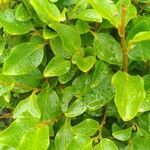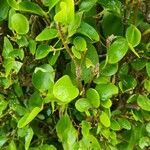Tree up to 10 m. or sts 15 m. tall, with short gnarled trunk up to 15 dm. diam. Lvs broad-ovate to ovate-oblong, rounded at apex, less glossy, slightly to not unequal-sided at base; main veins hardly prominent to obscure below. Panicles sts reduced to a simple racemes. Fls as in G. lucida but both ♂ and ♀ bearing petals. Fr. c. 6-7 mm. long.
A tree or shrub. It grows to 6-12 m high. It spreads 4.5 m wide. The leaves are dense and are bright green. They are leathery and oval. Plants are separately male and female. The flowers are pale green. The fruit are purple to black.



